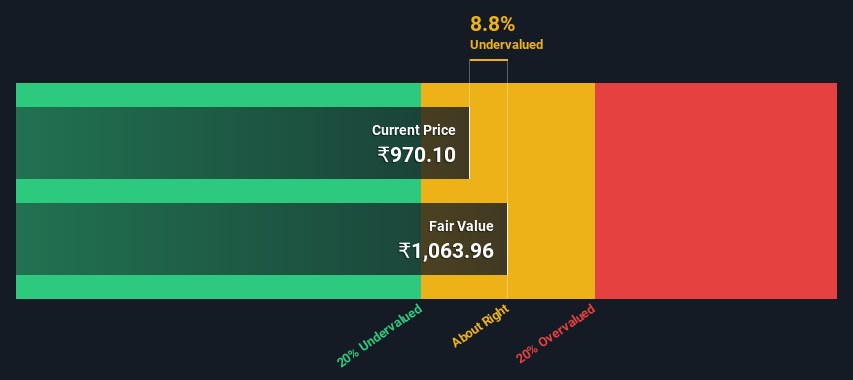- India
- /
- Oil and Gas
- /
- NSEI:GESHIP
Estimating The Fair Value Of The Great Eastern Shipping Company Limited (NSE:GESHIP)

Key Insights
- Using the 2 Stage Free Cash Flow to Equity, Great Eastern Shipping fair value estimate is ₹1,064
- Great Eastern Shipping's ₹970 share price indicates it is trading at similar levels as its fair value estimate
- Great Eastern Shipping's peers are currently trading at a premium of 73% on average
Today we'll do a simple run through of a valuation method used to estimate the attractiveness of The Great Eastern Shipping Company Limited (NSE:GESHIP) as an investment opportunity by taking the expected future cash flows and discounting them to their present value. One way to achieve this is by employing the Discounted Cash Flow (DCF) model. Models like these may appear beyond the comprehension of a lay person, but they're fairly easy to follow.
Remember though, that there are many ways to estimate a company's value, and a DCF is just one method. Anyone interested in learning a bit more about intrinsic value should have a read of the Simply Wall St analysis model.
View our latest analysis for Great Eastern Shipping
The Method
We use what is known as a 2-stage model, which simply means we have two different periods of growth rates for the company's cash flows. Generally the first stage is higher growth, and the second stage is a lower growth phase. In the first stage we need to estimate the cash flows to the business over the next ten years. Where possible we use analyst estimates, but when these aren't available we extrapolate the previous free cash flow (FCF) from the last estimate or reported value. We assume companies with shrinking free cash flow will slow their rate of shrinkage, and that companies with growing free cash flow will see their growth rate slow, over this period. We do this to reflect that growth tends to slow more in the early years than it does in later years.
A DCF is all about the idea that a dollar in the future is less valuable than a dollar today, and so the sum of these future cash flows is then discounted to today's value:
10-year free cash flow (FCF) forecast
| 2024 | 2025 | 2026 | 2027 | 2028 | 2029 | 2030 | 2031 | 2032 | 2033 | |
| Levered FCF (₹, Millions) | ₹22.5b | ₹17.7b | ₹17.6b | ₹17.9b | ₹18.5b | ₹19.2b | ₹20.2b | ₹21.3b | ₹22.5b | ₹23.9b |
| Growth Rate Estimate Source | Analyst x1 | Analyst x1 | Analyst x1 | Est @ 1.56% | Est @ 3.10% | Est @ 4.19% | Est @ 4.94% | Est @ 5.47% | Est @ 5.84% | Est @ 6.10% |
| Present Value (₹, Millions) Discounted @ 16% | ₹19.4k | ₹13.1k | ₹11.2k | ₹9.8k | ₹8.6k | ₹7.7k | ₹7.0k | ₹6.3k | ₹5.8k | ₹5.2k |
("Est" = FCF growth rate estimated by Simply Wall St)
Present Value of 10-year Cash Flow (PVCF) = ₹94b
The second stage is also known as Terminal Value, this is the business's cash flow after the first stage. For a number of reasons a very conservative growth rate is used that cannot exceed that of a country's GDP growth. In this case we have used the 5-year average of the 10-year government bond yield (6.7%) to estimate future growth. In the same way as with the 10-year 'growth' period, we discount future cash flows to today's value, using a cost of equity of 16%.
Terminal Value (TV)= FCF2033 × (1 + g) ÷ (r – g) = ₹24b× (1 + 6.7%) ÷ (16%– 6.7%) = ₹264b
Present Value of Terminal Value (PVTV)= TV / (1 + r)10= ₹264b÷ ( 1 + 16%)10= ₹58b
The total value is the sum of cash flows for the next ten years plus the discounted terminal value, which results in the Total Equity Value, which in this case is ₹152b. To get the intrinsic value per share, we divide this by the total number of shares outstanding. Compared to the current share price of ₹970, the company appears about fair value at a 8.8% discount to where the stock price trades currently. The assumptions in any calculation have a big impact on the valuation, so it is better to view this as a rough estimate, not precise down to the last cent.

Important Assumptions
Now the most important inputs to a discounted cash flow are the discount rate, and of course, the actual cash flows. If you don't agree with these result, have a go at the calculation yourself and play with the assumptions. The DCF also does not consider the possible cyclicality of an industry, or a company's future capital requirements, so it does not give a full picture of a company's potential performance. Given that we are looking at Great Eastern Shipping as potential shareholders, the cost of equity is used as the discount rate, rather than the cost of capital (or weighted average cost of capital, WACC) which accounts for debt. In this calculation we've used 16%, which is based on a levered beta of 1.237. Beta is a measure of a stock's volatility, compared to the market as a whole. We get our beta from the industry average beta of globally comparable companies, with an imposed limit between 0.8 and 2.0, which is a reasonable range for a stable business.
SWOT Analysis for Great Eastern Shipping
- Earnings growth over the past year exceeded the industry.
- Debt is not viewed as a risk.
- Dividends are covered by earnings and cash flows.
- Dividend is in the top 25% of dividend payers in the market.
- Earnings growth over the past year is below its 5-year average.
- Good value based on P/E ratio and estimated fair value.
- No apparent threats visible for GESHIP.
Moving On:
Although the valuation of a company is important, it ideally won't be the sole piece of analysis you scrutinize for a company. DCF models are not the be-all and end-all of investment valuation. Preferably you'd apply different cases and assumptions and see how they would impact the company's valuation. For instance, if the terminal value growth rate is adjusted slightly, it can dramatically alter the overall result. For Great Eastern Shipping, there are three important factors you should consider:
- Risks: Consider for instance, the ever-present spectre of investment risk. We've identified 3 warning signs with Great Eastern Shipping (at least 1 which is concerning) , and understanding them should be part of your investment process.
- Future Earnings: How does GESHIP's growth rate compare to its peers and the wider market? Dig deeper into the analyst consensus number for the upcoming years by interacting with our free analyst growth expectation chart.
- Other Solid Businesses: Low debt, high returns on equity and good past performance are fundamental to a strong business. Why not explore our interactive list of stocks with solid business fundamentals to see if there are other companies you may not have considered!
PS. The Simply Wall St app conducts a discounted cash flow valuation for every stock on the NSEI every day. If you want to find the calculation for other stocks just search here.
New: Manage All Your Stock Portfolios in One Place
We've created the ultimate portfolio companion for stock investors, and it's free.
• Connect an unlimited number of Portfolios and see your total in one currency
• Be alerted to new Warning Signs or Risks via email or mobile
• Track the Fair Value of your stocks
Have feedback on this article? Concerned about the content? Get in touch with us directly. Alternatively, email editorial-team (at) simplywallst.com.
This article by Simply Wall St is general in nature. We provide commentary based on historical data and analyst forecasts only using an unbiased methodology and our articles are not intended to be financial advice. It does not constitute a recommendation to buy or sell any stock, and does not take account of your objectives, or your financial situation. We aim to bring you long-term focused analysis driven by fundamental data. Note that our analysis may not factor in the latest price-sensitive company announcements or qualitative material. Simply Wall St has no position in any stocks mentioned.
About NSEI:GESHIP
Great Eastern Shipping
Through its subsidiaries, engages in the shipping and offshore businesses in India and internationally.
Flawless balance sheet, undervalued and pays a dividend.
Market Insights
Community Narratives



